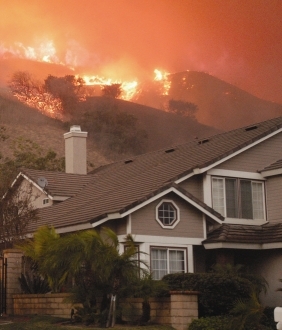
Large fires in the western U.S. — such as those currently raging in Colorado and New Mexico — may be part of a shifting pattern of wildfire risk brought on by climate change, according to a study led by researchers at UC Berkeley.
The study, published Tuesday in the journal Ecosphere, analyzed the results of 16 different global climate change models. The models included variables such as annual precipitation and mean temperature of the warmest month and projected an increase in the frequency of fires across the majority of North America and much of Europe within the next 30 years.
“In the long run, we found what most fear — increasing fire activity across large parts of the planet,” said study lead author Max Moritz, a fire specialist with UC Berkeley, in a press release. “But the speed and extent to which some of these changes may happen is surprising.”
While the models diverge in their predictions for certain parts of the world, there was wide agreement about a growing fire risk in the western United States, a conclusion that supports other recent studies.
[module align=”left” width=”half” type=”pull-quote”]”We need to learn how to build accordingly, to plan our neighborhoods and developments…and climate change is going to force our hand.” [/module]
Moritz said the findings do not account for short-term shifts in the climate, such those brought on by El Niño. He also cautioned against connecting the study’s results to, say, this week’s red flag warnings in northern California or the small weed fires that broke out this weekend in Milpitas and San Jose. Moritz pointed out these events are likely attributable to offshore winds – such as the Santa Anas and Diablos.
“None of these wind-related phenomena are built into our models,” said Moritz. “Like the El Niño signal, the global climate models do not give us good wind projections.”
However, he did offer a powerful takeaway message of the study to millions of Californians living in fire-prone areas.
“We don’t ‘fight’ earthquakes, floods or hurricanes. But we fight fire,” said Moritz. “The bottom line is that we need to learn to accommodate and coexist with this natural process, particularly in places like California. We need to learn how to build accordingly, to plan our neighborhoods and developments…And climate change is going to force our hand.”
3 thoughts on “New Study Projects More Frequent Fires for the Western U.S.”
Comments are closed.


I thought you had to have some intelligence to be a professor at Berkley. Has it ever occured to these people that the cause of such infernos has been a result of not conducting control burns to clear our forests and wildlands? The Native Americans used to do control burns to cleanse the forests in the Sierra Nevadas. Cones from certain conifers like the Sequoia cannot release their seeds unless it is subjected to fire. This enviromentalist earth worship whako voodoo science policy has tied the hands of our forestry people to clear brush and do control burns to renew the forest floor and to fertilize the forest floor (with ash). Because of this policy our wildlands have become infernoes waiting to happen and the result is these massive out-of-control fires.
@Patriotfarmgirl… I thought fire prevention was to protect homes, properties and lives not because of environmentalism. The west, especially Colorado is warmming much faster than other parts of the lower 48 so more fires is likely.
I live in mid- Michigan and the D.N.R. here have employed controlled burning for several years now. The result has been undeniably positive for the local eco-systems. The effect of controlled burning is also positive for people in homes near the area, as dry timber and dead foliage is burned in a predictable way, and not allowed to accumulate and become a massive fire risk. The sad thing is that this is still a philosophy that’s ahead of our time. The bottom line is always measured in dollars, and political interests. Any Environmentalist that does NOT support controlled burning is not really an Environmentalist!! It is a necessary part of the Global Life Cycle for things to burn and regrow. If that means we have to put forth extra efforts to protect individual species from being wiped out by fires, then so be it. We have many ways of rescuing wildlife. I hope Californian legislators will wake up and realize that at least part of their environmental legislature is obsolete.